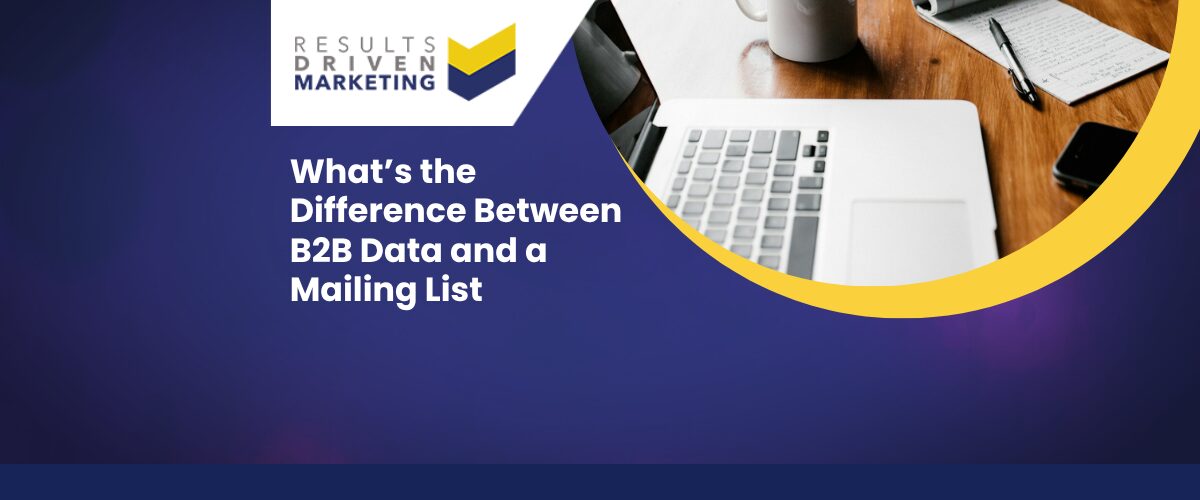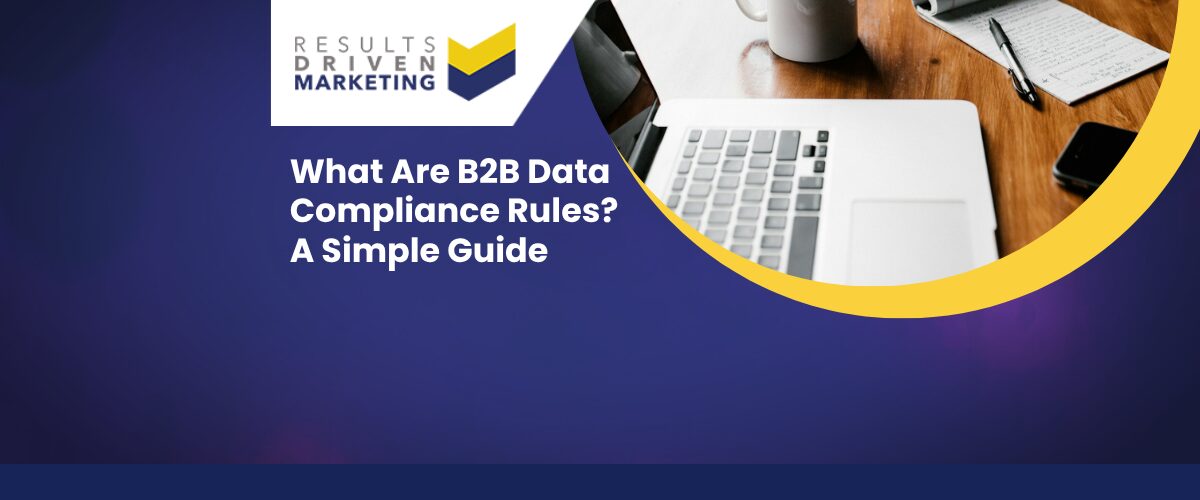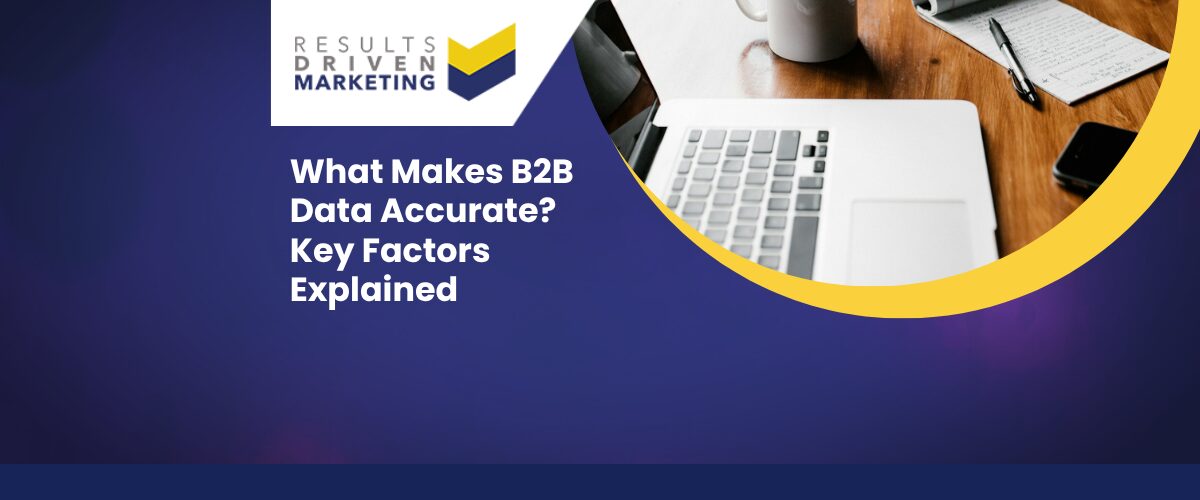What’s the difference between B2B data and a mailing list? It’s a common question — and one that catches out a lot of UK SMEs looking to run campaigns fast. On the surface, they sound similar: a list of businesses you can contact. But scratch a little deeper and the gap between them can mean the difference between wasted spend and real results.
Too often, businesses are sold basic mailing lists when what they really need is structured, campaign-ready B2B data. The result? Poor targeting, low engagement, and a frustrated sales or marketing team wondering why their outreach isn’t landing.
This guide breaks down the difference in plain English. We’ll show you what each option includes, where the value lies, and how to avoid buying something that just doesn’t work for your goals. And we’ll explain how Results Driven Marketing helps you choose the right data — not just the nearest fit.
Table of contents:
Why the Confusion Exists
If you’ve ever felt unsure about whether you need a “mailing list” or “B2B data,” you’re not alone. The two terms are often used interchangeably — especially by providers who prioritise sales over clarity.
Here’s why it’s easy to get mixed up:
-
Marketing language blurs the lines. Some sellers use “mailing list” to describe any kind of contact data — whether it’s just names and addresses or a full contact profile.
-
No industry standard. Unlike legal or accounting services, there’s no clear definition across the B2B data world — so every supplier describes their product differently.
-
SMEs are time-pressed. Many buyers don’t have the time to deep-dive specs, so they go with what sounds familiar — often to the detriment of campaign results.
Understanding the core differences upfront helps you make a more informed, cost-effective decision — and choose the right tool for your campaign.
What Is a Mailing List?
A mailing list is often the most basic form of business contact data — designed primarily for one-off postal or generic email campaigns. It can be useful in specific situations, but it’s important to understand its limits.
Typical Structure
-
Basic company details only — business name, address, and sometimes postcode
-
Generic email addresses — info@, enquiries@, or sales@ rather than named contacts
-
Minimal segmentation — often only by geography or very broad industry category
-
Primarily for post or generic email blasts — not structured for targeted, personalised outreach
Limitations
-
Lacks decision-maker details — no job titles or named contacts
-
Poor segmentation options — hard to filter by company size, sector, or role
-
Limited lifespan — mailing lists go out of date quickly, and rarely get refreshed
-
Not campaign-ready — often needs additional formatting or enrichment to be useful in CRMs or automation tools
If you’re just planning a flyer drop or local campaign, a mailing list might suffice. But for anything more strategic, it usually falls short.
What Is a B2B Data List?
Unlike a basic mailing list, B2B data is designed for targeted, multichannel outreach. It includes deeper, more structured information — ideal for sales and marketing teams looking to connect with the right people, not just any people.
Typical Structure
-
Full business profile — company name, address, industry, turnover, and size
-
Named contact details — first name, last name, job title, department
-
Direct contact information — business email addresses, phone numbers, and sometimes LinkedIn URLs
-
Segmentation-ready fields — filters by region, sector, job role, employee size, and more
-
Formatted for CRM/automation — data structured to plug straight into your systems
Benefits
-
More precise targeting — reach the decision-makers who matter, not just a front desk
-
Supports multiple channels — email, phone, and post all from the same file
-
Boosts campaign effectiveness — tailored messaging equals better results
-
Easier to scale — filter and refine your lists for future campaigns
-
Better ROI — more conversions, fewer wasted contacts, and cleaner follow-up data
If you’re running outbound sales, email campaigns, or anything that needs real targeting, B2B data is the smarter long-term investment.
Mailing List vs B2B Data – Key Differences
If you’re deciding between a mailing list and a full B2B data file, this comparison will help you see where they diverge — and which one fits your goals best.
Comparison Table
| Feature | Mailing List | B2B Data |
|---|---|---|
| Contacts | Often generic (info@) | Named decision-makers |
| Channels | Usually mail/email | Email, phone, and post |
| Segmentation | Limited | Filterable by role, sector, region, size |
| Use Cases | Simple mailouts | Multi-channel lead generation |
| Data Depth | Shallow, broad | Rich, structured, campaign-ready |
Which One Do You Need?
-
If you’re doing a one-off flyer drop → A simple mailing list might work
-
If you’re running lead gen or cold outreach → You’ll want full B2B data
-
If you’re not sure → Start with B2B data — it offers more flexibility, depth, and future value
The bottom line: mailing lists are static and shallow. B2B data is dynamic, structured, and designed to get results across channels.
What to Watch Out For When Buying
Not all data providers are upfront about what you’re actually getting. Here are a few red flags and tips to help you make an informed purchase:
-
Vague product descriptions
If the supplier can’t clearly explain what fields are included, or just says “contact list,” be cautious. -
Mailing list mislabelled as B2B data
Some sellers pitch low-detail records with generic contacts as “B2B leads” — but they’re little more than a basic file. -
No targeting options offered
If they can’t filter by sector, size, or role, you’re likely getting a static list, not tailored data. -
Unclear on delivery format
Make sure you know whether the file is ready for use — or needs manual formatting and clean-up. -
Price too low to be true
High-quality B2B data has value. If a provider quotes a rock-bottom price, it’s likely out-of-date or overly generic.
Ask direct questions and request specifics — your campaigns depend on it.
Why Choose Results Driven Marketing
When clients ask us what’s the difference between B2B data and a mailing list, we don’t just give them a definition — we show them the difference in results.
At Results Driven Marketing, we go far beyond generic data. Our lists are built for SMEs who need real contacts, fast delivery, and smart targeting — not just a spreadsheet of names.
We Offer More Than Just Names
-
Every list is built to your brief — no recycled data
-
Target by role, region, industry, company size, and more
-
Multi-channel delivery: email, phone, and post fields included
-
All data is GDPR and CTPS checked and formatted for immediate use
Structured for Outreach Success
-
Over 700,000 updates monthly from top UK sources
-
40-point data quality check before delivery
-
95%+ accuracy standards across email, phone, and post
Honest Advice and Fast Delivery
-
We’ll guide your brief to avoid wasting budget
-
Same-day turnaround on most jobs
-
Real support from UK-based data specialists who care about your outcomes
We’re not just here to sell you data — we’re here to help you grow your business with it.
Final Thoughts – Know What You’re Buying
Understanding what’s the difference between B2B data and a mailing list isn’t just semantics — it’s about making smarter decisions with your marketing budget.
Mailing lists have their place for basic, broad outreach. But if your goal is lead generation, personalised follow-up, or multichannel campaigns, B2B data is the tool you need. It’s structured, filterable, and built to support actual business growth.
At Results Driven Marketing, we help UK SMEs cut through the noise and get the right data for the right campaign. No generic lists. No guesswork. Just targeted B2B contacts that get results — fast.
✅ Need help choosing the right data?
Contact us for a free consultation or buy email lists structured for real campaign success.
Results Driven Marketing
UK B2B data specialists helping SMEs grow with accurate, campaign-ready marketing lists.
📞 0191 406 6399 | rdmarketing.co.uk
Based at Cobalt Business Exchange, Newcastle upon Tyne





